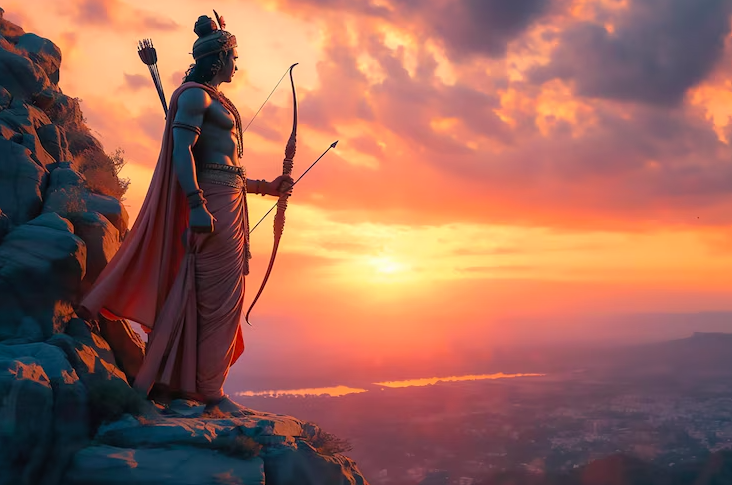For millennia, Shree Ram has stood as a beacon of virtue, courage, and ideal governance. Revered as the seventh avatar of Vishnu in Hinduism, his story – immortalized in the Ramayana – is deeply interwoven into the cultural, ethical, and spiritual fabric of India.
But beyond the celestial verses and temple idols, Shree Ram emerges as a deeply human and historical figure, whose legacy was shaped by time, recorded in inscriptions, and remembered across continents.
This blog explores the historical roots, hidden layers, and lesser-known truths about Shree Ram – not just as a deity but as a real ruler, a strategic warrior, and a man whose life inspired global reverence.
1. The City of Ayodhya – More Than Myth
Modern Ayodhya may look like a humble town in Uttar Pradesh, but ancient Ayodhya was the grand capital of Kosala, one of the oldest Vedic kingdoms.
- Excavations by ASI (2003) revealed pillar bases and temple ruins beneath the Babri Masjid.
- The Vishnu-Hari inscription describes the construction of a temple for the “slayer of the ten-headed one” – a direct reference to Ram.
- Worship continued at the site even during Mughal and British periods.
2. Ram in Jain and Buddhist Traditions
Yes, Shree Ram exists outside Hindu texts too!
- In Jainism, Ram is known as Padma, and unlike the Hindu version, Lakshman kills Ravana, while Ram attains moksha.
- In Buddhism, the Dasaratha Jataka portrays Ram as a Bodhisattva – an enlightened being in a previous birth of the Buddha.
These cross-religious depictions speak volumes about Ram’s universal moral appeal.
3. The Global Echo of Ramayana
Across Southeast Asia, Shree Ram’s saga lives on in royal chronicles, art, and dance dramas:
- Thailand – Ram is the hero of the Ramakien.
- Indonesia – The Kakawin Ramayana is a poetic version of his story.
- Cambodia – The Reamker blends Ramayana with Khmer mythology.
- Vietnam and China – Oral traditions echo the tale of a noble warrior prince.
🔗 Ramayana Across Cultures – HinduWebsite
4. Astronomical Dating of Ram’s Era
The Valmiki Ramayana contains over 600 astronomical cues—planet positions, eclipses, and star alignments.
- Scholars like Dr. Nilesh Oak and Dr. P.V. Vartak analyzed these cues using planetarium software.
- Estimated birth date: 10 January 5114 BCE
- Estimated exile date: 29 November 5089 BCE
While controversial, these studies strive to anchor Ram’s life in real time.
🔗 Astronomical Evidence – Indica Today
5. Shree Ram: Warrior & Tactician
Ram’s warfare was more than brute strength:
- Used guerrilla tactics, espionage (Hanuman’s Lanka visit), and diplomacy.
- The famous Rama Setu (Adam’s Bridge) connecting India and Lanka has geological features some claim are man-altered.
- He adhered to battle ethics – offered peace first, mourned slain enemies, and never attacked unfairly.
Strategic Warfare in Ramayana – Indian Defence Review
6. Rama Rajya – Ideal Governance
The phrase Rama Rajya still defines utopian governance in Indian thought.
- Ruling with justice, equality, and compassion.
- Emphasis on public consultation, dharma, and truth.
- No discrimination between rich and poor, insider and outsider.
7. Lesser-Known Facts about Shree Ram
- Ram’s lineage traces back to the Solar Dynasty founder, Ikshvaku.
- He ruled for 11,000 years, according to the Ramayana (symbolic of a golden era).
- His sons, Luv and Kush, are believed to have ruled Northern India.
- In tribal and folk traditions, Ram is revered more as a warrior-king than a divine avatar.
Man, Myth, Memory
Shree Ram is more than a myth. He’s a moral compass, a political visionary, a master tactician, and a symbol of what humanity can strive to be. From the dusty lanes of Ayodhya to global shrines and digital screens, his legacy lives not because he was divine—but because he was deeply human.
Let us remember him not just as a god in the temple—but as a king who led with dharma, and as a man who stood tall amidst chaos, heartbreak, and exile.
🔗 References & Suggested Reading
- ASI Report on Ayodhya Excavation (2003)
- Ramayana in World Cultures – HinduWebsite
- Sri Rama in Jainism
- Dating the Ramayana – Indica Today
- Gandhi and Rama Rajya

Leave a Reply